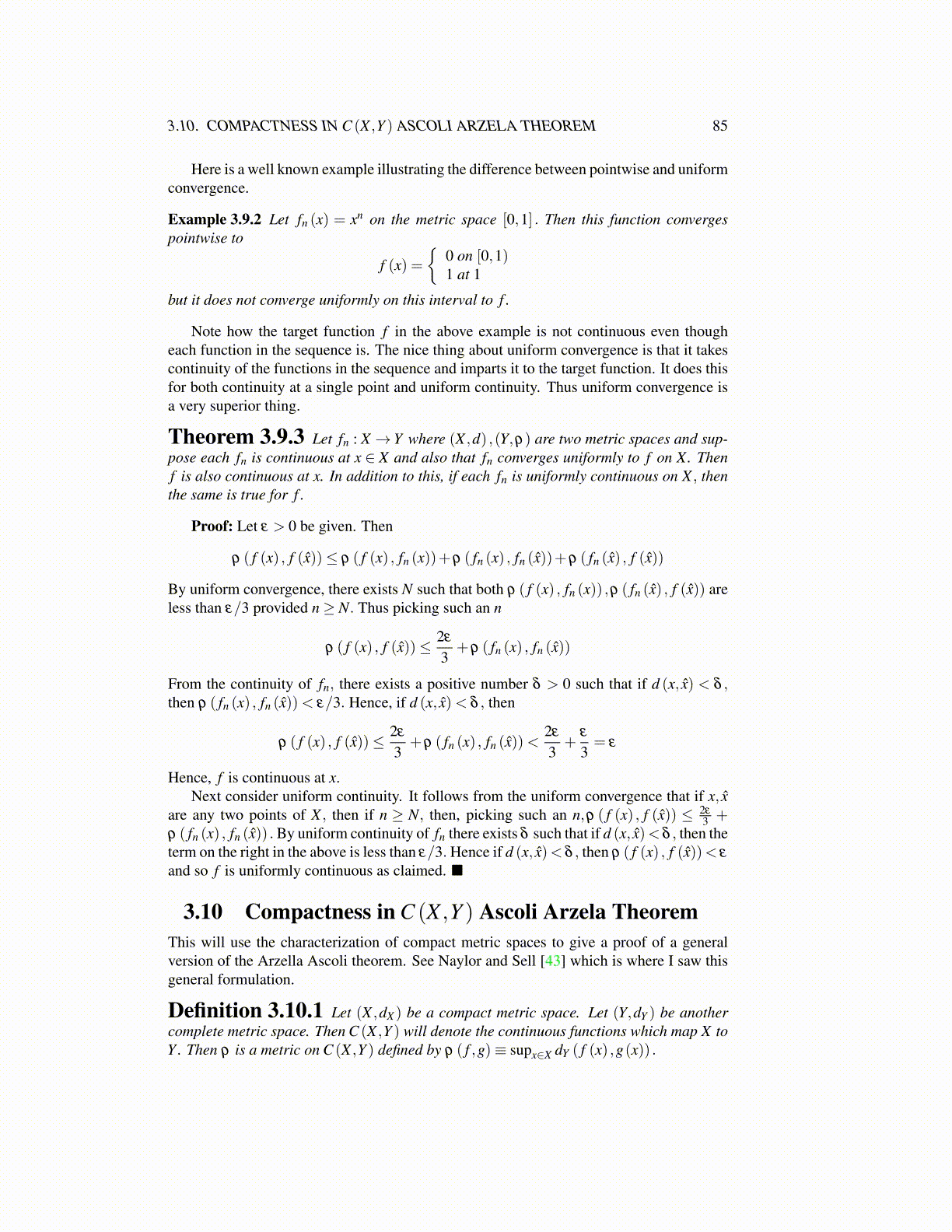
3.10. COMPACTNESS IN C (X ,Y ) ASCOLI ARZELA THEOREM 85
Here is a well known example illustrating the difference between pointwise and uniformconvergence.
Example 3.9.2 Let fn (x) = xn on the metric space [0,1] . Then this function convergespointwise to
f (x) ={
0 on [0,1)1 at 1
but it does not converge uniformly on this interval to f .
Note how the target function f in the above example is not continuous even thougheach function in the sequence is. The nice thing about uniform convergence is that it takescontinuity of the functions in the sequence and imparts it to the target function. It does thisfor both continuity at a single point and uniform continuity. Thus uniform convergence isa very superior thing.
Theorem 3.9.3 Let fn : X → Y where (X ,d) ,(Y,ρ) are two metric spaces and sup-pose each fn is continuous at x ∈ X and also that fn converges uniformly to f on X. Thenf is also continuous at x. In addition to this, if each fn is uniformly continuous on X , thenthe same is true for f .
Proof: Let ε > 0 be given. Then
ρ ( f (x) , f (x̂))≤ ρ ( f (x) , fn (x))+ρ ( fn (x) , fn (x̂))+ρ ( fn (x̂) , f (x̂))
By uniform convergence, there exists N such that both ρ ( f (x) , fn (x)) ,ρ ( fn (x̂) , f (x̂)) areless than ε/3 provided n≥ N. Thus picking such an n
ρ ( f (x) , f (x̂))≤ 2ε
3+ρ ( fn (x) , fn (x̂))
From the continuity of fn, there exists a positive number δ > 0 such that if d (x, x̂) < δ ,then ρ ( fn (x) , fn (x̂))< ε/3. Hence, if d (x, x̂)< δ , then
ρ ( f (x) , f (x̂))≤ 2ε
3+ρ ( fn (x) , fn (x̂))<
2ε
3+
ε
3= ε
Hence, f is continuous at x.Next consider uniform continuity. It follows from the uniform convergence that if x, x̂
are any two points of X , then if n ≥ N, then, picking such an n,ρ ( f (x) , f (x̂)) ≤ 2ε
3 +ρ ( fn (x) , fn (x̂)) . By uniform continuity of fn there exists δ such that if d (x, x̂)< δ , then theterm on the right in the above is less than ε/3. Hence if d (x, x̂)< δ , then ρ ( f (x) , f (x̂))< ε
and so f is uniformly continuous as claimed. ■
3.10 Compactness in C (X ,Y ) Ascoli Arzela TheoremThis will use the characterization of compact metric spaces to give a proof of a generalversion of the Arzella Ascoli theorem. See Naylor and Sell [43] which is where I saw thisgeneral formulation.
Definition 3.10.1 Let (X ,dX ) be a compact metric space. Let (Y,dY ) be anothercomplete metric space. Then C (X ,Y ) will denote the continuous functions which map X toY . Then ρ is a metric on C (X ,Y ) defined by ρ ( f ,g)≡ supx∈X dY ( f (x) ,g(x)) .